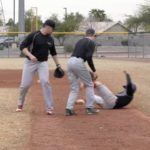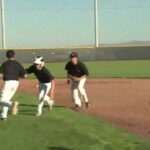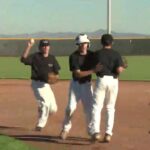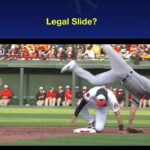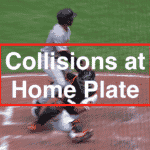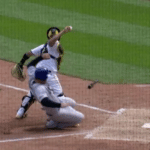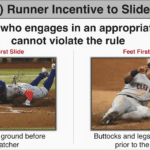NCAA 8-7 Collision Rule
Collision Rule
SECTION 7. The rules committee is concerned about unnecessary and violent collisions with the catcher at home plate, and with infielders at all bases. The intent of this rule is to encourage base runners and defensive players to avoid such collisions whenever possible.
a. When there is a collision between a runner and a fielder who is in clear possession of the ball, the umpire shall judge:
If the defensive player blocks the base (plate) or base line with clear possession of the ball, the runner may slide into to make contact with the fielder as long as the runner is making a legitimate attempt to reach the base (plate).
1) The runner must make an actual attempt to reach the base (plate).
PENALTY—If the contact is flagrant or malicious before the runner touches the base (plate), the runner shall be declared out and also ejected from the contest. The ball is immediately dead and all other base runners shall return to the last base touched at the time of the collision.
2) The runner may not attempt to dislodge the ball from the fielder. Contact above the waist shall be judged by the umpire as an attempt by the runner to dislodge the ball.
PENALTY— If the runner attempts to dislodge the ball or initiates an avoidable collision, the runner shall be declared out, even if the fielder loses possession of the ball. The ball is dead and all other base runners shall return to the last base touched at the time of the collision.
3) The runner must attempt to avoid a collision if he can reach the base without colliding.
PENALTY—If the contact is flagrant or malicious after the runner touches the base (plate), the runner is safe, but is ejected from the contest. The ball is immediately dead and all other base runners shall return to the last base touched at the time of the collision. If this occurs at any base other than home, the offending team may replace the runner. If the contact occurs after a preceding runner touches home plate, the preceding runner is safe. The ball is immediately dead and all other base runners shall return to the last base touched at the time of the contact.
4) If the runner’s path to the base is blocked and (1), (2) and (3) are fulfilled, it is considered unavoidable contact (see Rule 2-55, Obstruction).
b. A runner attempting to score may not deviate from his direct pathway to the plate in order to initiate contact with the catcher (or other player covering home plate), or otherwise initiate an avoidable collision. If, in the judgment of the umpire, a runner attempting to score initiates contact with the catcher (or other player covering home plate) in such a manner, the umpire shall declare the runner out (regardless of whether the player covering home plate maintains possession of the ball). In such circumstances, the umpire shall call the ball dead, and all other base runners shall return to the last base touched at the time of the collision. If the runner slides into the plate in an appropriate manner, he shall not be adjudged to be in violation of this rule.
Note: The failure by the runner to make an effort to touch the plate, the runner’s lowering of the shoulder, or the runner’s pushing through with his hands, elbows or arms, would support a determination that the runner deviated from the pathway in order to initiate contact with the catcher in violation of the Collision Rule 8-7, or otherwise initiated a collision that could have been avoided. A slide shall be deemed appropriate, in the case of a feet first slide, if the runner’s buttocks and legs should hit the ground before contact with the catcher. In the case of a head first slide, a runner shall be deemed to have slid appropriately if his body should hit the ground before contact with the catcher. If a catcher blocks the pathway of the runner, the umpire shall not find that the runner initiated an avoidable collision in violation of the Collision Rule.
c. Unless the catcher is in possession of the ball, the catcher cannot block the pathway of the runner as he is attempting to score. If, in the judgment of the umpire, the catcher without possession of the ball blocks the pathway of the runner, the umpire shall call or signal the runner safe. Notwithstanding the above, it shall not be considered a violation if the catcher blocks the pathway of the runner in a legitimate attempt to field the throw, (e.g., in reaction to the direction, trajectory or the hop of the incoming throw, or in reaction to a throw that originates from the pitcher or drawn-in infielder). In addition, a catcher without possession of the ball shall not be adjudged to be in violation if the runner could have avoided the collision with the catcher (or other player covering home plate) by sliding.
Note: A catcher shall not be deemed to have violated the Collision Rule unless he has both blocked the plate without possession of the ball (or when not in a legitimate attempt to field the throw), and also hindered or impeded the progress of the runner attempting to score. A catcher shall not be deemed to have hindered or impeded the progress of the runner if, in the judgment of the umpire, the runner would have been called out notwithstanding the catcher having blocked the plate. In addition, a catcher should use best efforts to avoid unnecessary and forcible contact while tagging a runner attempting to slide. Catchers who routinely make unnecessary and forcible contact with a runner attempting to slide (e.g., by initiating contact using a knee, shin guard, elbow or forearm) may be subject to being ejected.

